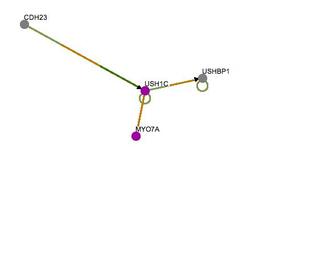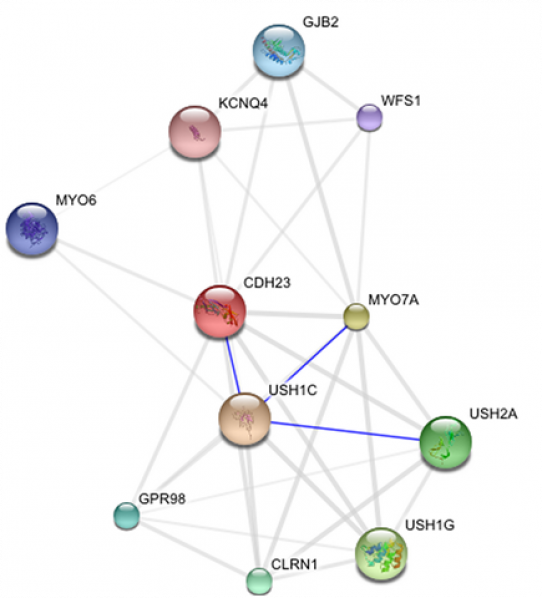This web page was produced as an assignment for Genetics 677, an undergraduate course at UW-Madison
Osprey Interactions with Human CDH23
Click on images to enlarge.
The left image illustrates CDH23 with 2 degrees of interaction, whereas the right displays 3 degrees.
The left image illustrates CDH23 with 2 degrees of interaction, whereas the right displays 3 degrees.
Analysis:
Human cdh23 interacts directly with one known protein, USH1C, which in turn interacts with itself as well as MYO7A and USHBP1. Osprey tells us that USH1C is involved in cell organization and biogenesis, and could therefore play a role in the localization of cdh23. In fact, the source establishing the primary connection between cdh23 and USH1C found that both proteins are found in growing stereocilia and they bind. They also report that the harmonin b protein subtype is likely responsible for "anchoring cadhrin 23 to the stereocilia microfilaments" because it is an F-actin-bundling protein.
This subtype was shown to be absent in non-functional mutant myosin VIIA (one of the 2nd degree proteins) mice. This suggested that wild-type myosin VIIA recruits harmonin b, which is required for normal stereocilia hair bundling. (Boëda B, 2002)
Human cdh23 interacts directly with one known protein, USH1C, which in turn interacts with itself as well as MYO7A and USHBP1. Osprey tells us that USH1C is involved in cell organization and biogenesis, and could therefore play a role in the localization of cdh23. In fact, the source establishing the primary connection between cdh23 and USH1C found that both proteins are found in growing stereocilia and they bind. They also report that the harmonin b protein subtype is likely responsible for "anchoring cadhrin 23 to the stereocilia microfilaments" because it is an F-actin-bundling protein.
This subtype was shown to be absent in non-functional mutant myosin VIIA (one of the 2nd degree proteins) mice. This suggested that wild-type myosin VIIA recruits harmonin b, which is required for normal stereocilia hair bundling. (Boëda B, 2002)
STRING Interactive Protein Map
Analysis:
String confirms that CDH23 primarily acts only on USH1C and, USH1C only primarily acts on MYO7A and USH2A. The blue lines indicate that all interactions are binding interactions. One could test the temporal binding patterns of CDH23 with USH1C, and USH1C with the other two, to see if binding occurs at the same time. If so these four proteins may all be involved in creating the tip link complex bridging stereocilia.
String confirms that CDH23 primarily acts only on USH1C and, USH1C only primarily acts on MYO7A and USH2A. The blue lines indicate that all interactions are binding interactions. One could test the temporal binding patterns of CDH23 with USH1C, and USH1C with the other two, to see if binding occurs at the same time. If so these four proteins may all be involved in creating the tip link complex bridging stereocilia.
References:
Osprey: http://biodata.mshri.on.ca/osprey/srvlet/Index
Boeda B et al. Myosin VIIa, harmonin and cadherin 23, three Usher I gene products that cooperate to shape the sensory hair cell bundle. EMBO J. 2002. 21(24):6689-99.
String 8.2: http://string-db.org/
Ben Hofeld, [email protected], last updated: 5.15.2010, Link to course page:www.gen677.weebly.com



